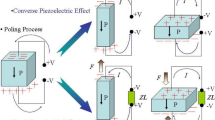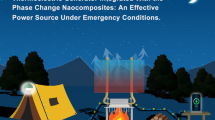Abstract
Due to its excellent piezoelectric characteristics and Curie temperatures, PZT-5H piezoelectric ceramics are perfect for creating low-temperature co-fired multilayer devices. The effects of Bi2O3 doping on the low-temperature sintering properties of PZT-5H ceramic powder were investigated in this work. When the mass fraction of Bi2O3 is 0.9%, PZT-5H ceramics can be completely sintered at 850°C. In addition, the chemical composition exhibits the best electrical properties at this doping level and lies at the morphological phase boundary (MPB). The property is as follows: d33 = 504pC/N, tan δ = 0.0296, kp = 0.653, Qm = 30.983, and Tc = 230°C. A multilayer piezoelectric ceramic actuator was created in this work to better demonstrate the real-world applications of using this material in low-temperature co-fired devices. The multilayer piezoelectric actuator’s characterization revealed that the material was tightly attached to the Ag electrode, and that there was minimal Ag diffusion at the bond, with satisfactory co-firing matching. At a drive voltage of 600 V, the multilayer actuator produced a displacement of 2.18 μm and a strain value of 0.109%. This showed that it was feasible to create multilayer piezoelectric ceramic actuators with this material, and that it provides a new alternative material for creating other multilayer piezoelectric ceramic devices.











Similar content being viewed by others
References
Y. Luo, T. Pu, S. Fan, H. Liu, and J. Zhu, Enhanced piezoelectric properties in low-temperature sintering PZN–PZT ceramics by adjusting Zr/Ti ratio. J. Adv. Dielectr. 12, 6 (2022).
S.W. Kim, J.J. Yong, and H.C. Lee, Effects of the mixing method and sintering temperature on the characteristics of PZNN–PZT piezoelectric ceramic materials. J. Korean Powder Metall. Inst. 25, 487 (2018).
X.Y. Gao, X.D. Xin, J.G. Wu, Z.Q. Chu, and S.X. Dong, A multilayered-cylindrical piezoelectric shear actuator operating in shear (d15) mode. App. Phys. Lett. 112, 152902 (2018).
X.Y. Gao, Z.M. Li, J.G. Wu, X.D. Xin, X.Y. Shen, X.T. Yuan, J.K. Yang, Z.Q. Chu, and S.X. Dong, A piezoelectric and electromagnetic dual mechanism multimodal linear actuator for generating macro- and nanomotion. Research 2019, 8232097 (2019).
R. Nie, Q. Zhang, Y. Yue, H. Liu, Y. Chen, Q. Chen, J. Zhu, P. Yu, and D. Xiao, Phase structure–electrical property relationships in Pb(Ni1/3Nb2/3)O3–Pb(Zr, Ti)O3-based ceramics. J. Appl. Phys. 119, 124111 (2016).
K. Wen, J.H. Qiu, H.L. Ji, K.J. Zhu, J.S. Liu, J. Wang, J.Z. Du, and F.L. Zhu, Investigation of phase diagram and electrical properties of xPb(Mg1/3Nb2/3)O3–(1−x)Pb(Zr0.4Ti0.6)O3 ceramics. J. Mater. Sci. Mater. Electron. 25, 3003 (2014).
S.Y. Kweon, K.S. Lee, Y.M. Park, and M.S. Yoon, Low-temperature sintering of (1−x)Pb(Zr0.53Ti0.47)O3–xBiYO3 ceramics with nano-powder for piezo-speaker. Jpn. J. Appl. Phys. 58, 9 (2019).
W. Zhang and R.E. Eitel, Sintering behavior, properties, and applications of co-fired piezoelectric/low temperature co-fired ceramic (PZT–SKN/LTCC) multilayer ceramics. Int. J. Appl. Ceram. Technol. 2, 354 (2013).
H. Chen, T. Pu, Y. Luo, S. Fan, Q. Chen, H. Liu, and J. Zhu, Enhancement of piezoelectric properties in low-temperature sintering PZN–PZT ceramics by Sr2+ substitution. J. Electron. Mater. 51, 1261 (2022).
H. Chen, T. Pu, S. Fan, H. Liu, J. Zhu, and Q. Chen, Enhanced electrical properties in low-temperature sintering PNN–PMW–PZT ceramics by Yb2O3 doping. Mater. Res. Bull. 146, 111576 (2022).
C.H. Nam, H.Y. Park, I.T. Seo, J.H. Choi, S. Nahm, and H.G. Lee, Effect of CuO on the sintering temperature and piezoelectric properties of MnO2-doped 0.75Pb(Zr0.47Ti0.53)O3–0.25Pb(Zn1/3Nb2/3)O3 ceramics. J. Alloys Compd. 509, 3686 (2011).
Y. Jeong, J. Yoo, S. Lee, and J. Hong, Piezoelectric characteristics of low temperature sintering Pb(Mn1/3Nb2/3)O3–Pb(Ni1/3Nb2/3)O3–Pb(Zr0.50Ti0.50)O3 according to the addition of CuO and Fe2O3. Sens. Actuators A Phys. 135, 215 (2007).
Y.D. Hou, M.K. Zhu, H. Wang, B. Wang, H. Yan, and C.S. Tian, Effects of CuO addition on the structure and electrical properties of low temperature sintered Pb((Zn1/3Nb2/3)(0.20)(Zr0.50Ti0.50)(0.80))O3 ceramics. Mater. Sci. Eng. B Solid State Mater. Adv. Technol. 110, 27 (2004).
C.W. Ahn, H.C. Song, S. Nahm, and S. Priya, Effect of ZnO and CuO on the sintering temperature and piezoelectric properties of a hard piezoelectric ceramic. J. Am. Ceram. Soc. 89, 921 (2006).
J.Q. Yi, S.L. Jiang, S.S. Liu, L. Zhang, and J.G. He, Effects of LiBiO2 addition on the microstructure and piezoelectric properties of CuO-doped PNN–PZT ceramics. Phys. Status Solidi A Appl. Mater. 211, 2552 (2014).
S.C. Hong, S.Y. Kim, D.H. Yeo, H.S. Shin, Z.H. Park, and S. Nahm, Effect of LiBiO2 on low-temperature sintering of PZT–PZNN ceramics. J. Korean Ceram. Soc. 59, 638 (2022).
J. Zhang, Y.S. Zhang, Z.M. Yan, A.J. Wang, P. Jiang, and M. Zhong, Fabrication and performance of PNN–PZT piezoelectric ceramics obtained by low-temperature sintering. Sci. Eng. Compos. Mater. 27, 359 (2020).
L. Shi, P.L. Wu, L.T. Yu, Y. Zhao, Z. Li, W.Y. Zhao, Z. Wang, Y.Z. Peng, W.J. Hua, J. Wang, R.X. Song, and W.D. Fei, Enhanced piezoelectric properties and phase transition in PZT ceramics induced by Li+-Sm3+ ionic pairs. Ceram. Int. 48, 10024 (2022).
D.L. Corker, R.W. Whatmore, E. Ringgaard, and W.W. Wolny, Liquid-phase sintering of PZT ceramics. J. Eur. Ceram. Soc. 20, 2039 (2000).
T.C. Zhou, H.W. Zhang, L.J. Jia, J. Li, Y.L. Liao, L.C. Jin, and H. Su, Grain growth, densification, and gyromagnetic properties of LiZnTi ferrites with H3BO3–Bi2O3–SiO2–ZnO glass addition. J. Appl. Phys. 115, 3 (2014).
Y.C. Zhang, W.N. Ye, Z.Z. Yang, C.J. Lu, and L.H. Xia, Effect of excess Pb on formation of perovskite-type 0.67Pb(Mg1/3Nb2/3)O3–0.33PbTiO3 powders synthesized through a sol–gel process. J. Mater. Sci. Mater. Electron. 22, 91 (2011).
D. Saha, A. Sen, and H.S. Maiti, The role of dilatancy on expansion during early stage liquid phase sintering of lead magnesium niobate. Ceram. Int. 27, 51 (2001).
Q. Zhang, Y. Yue, R. Nie, H. Liu, Q. Chen, P. Yu, J.G. Zhu, and D.Q. Xiao, Achieving both high d33 and high Tc in low-temperature sintering Pb (Ni1/3Nb2/3)O3–Pb(Mg1/2W1/2)O3–Pb(Zr0.5Ti0.5)O3 ceramics using Li2CO3. Mater. Res. Bull. 85, 96 (2017).
Y.K. Zeng, F. Yao, G.Z. Zhang, S.S. Liu, S.L. Jiang, Y. Yu, J.G. He, L. Zhang, and J.Q. Yi, Effects of Bi2O3–Li2CO3 additions on dielectric and pyroelectric properties of Mn doped Pb(Zr0.9Ti0.1)O3 thick films. Ceram. Int. 39, 3709 (2013).
H. Zhang, J. Shen, J. Tian, J. Zhou, and W. Chen, Elastic, dielectric and piezoelectric properties of Fe2O3 doped PMnS–PZN–PZT ceramics. Ferroelectrics 491, 15 (2016).
B. Shao, J.H. Qiu, K.J. Zhu, Y. Cao, and H.L. Ji, Effect of CuO on dielectric and piezoelectric properties of (K0.4425Na0.52Li0.0375)(Nb0.87Ta0.06Sb0.07)O3 ceramics. J. Alloys Compd. 515, 128 (2012).
Y.R. Wang, and S.F. Wang, Liquid phase sintering of NiCuZn ferrite and its magnetic properties. Int. J. Inorg. Mater. 3, 1189 (2001).
S. Li, J. Fu, and R.Z. Zuo, Middle-low temperature sintering and piezoelectric properties of CuO and Bi2O3 doped PMS–PZT based ceramics for ultrasonic motors. Ceram. Int. 47, 20117 (2021).
A.V. Polotai, A.V. Ragulya, and C.A. Randall, Preparation and size effect in pure nanocrystalline barium titanate ceramics. Ferroelectrics 288, 93 (2003).
Acknowledgments
This work was supported by the National Natural Science Foundation of China (Grant Nos. U1806221, 51672198, 51572204 and 51072146), Innovation and Development Project of Zibo City (2017CX01A022), Instruction & Development Project for National Funding Innovation Demonstration Zone of Shandong Province (2018ZCQZB01, 2019ZCQZB03), Central Guiding Local Science and Technology Development Special Funds (Grant Nos. 2060503), and Key Research & Design Program of Shandong Province (2019GGX102011).
Author information
Authors and Affiliations
Corresponding author
Ethics declarations
Conflict of interest
No conflict of interest exits in the submission of this manuscript, and manuscript is approved by all authors for publication.
Additional information
Publisher's Note
Springer Nature remains neutral with regard to jurisdictional claims in published maps and institutional affiliations.
Rights and permissions
Springer Nature or its licensor (e.g. a society or other partner) holds exclusive rights to this article under a publishing agreement with the author(s) or other rightsholder(s); author self-archiving of the accepted manuscript version of this article is solely governed by the terms of such publishing agreement and applicable law.
About this article
Cite this article
Mao, W., Xu, Q., Huang, D. et al. Low-Temperature Sintering Properties of Bi2O3 Doped PZT-5H Piezoelectric Ceramics. J. Electron. Mater. 52, 3334–3342 (2023). https://doi.org/10.1007/s11664-023-10312-1
Received:
Accepted:
Published:
Issue Date:
DOI: https://doi.org/10.1007/s11664-023-10312-1




